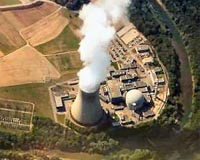 |
Tokyo (AFP) May 6, 2011 Japan's Prime Minister Naoto Kan on Friday ordered the suspension of operations at an ageing nuclear power plant southwest of Tokyo because it is located close to a dangerous tectonic faultline. It comes eight weeks after a massive quake and tsunami damaged the Fukushima Daiichi nuclear power plant northeast of Tokyo, sparking the world's worst atomic crisis since Chernobyl a quarter-century ago. Seismologists have long warned that a major quake is far overdue in the Tokai region southwest of Tokyo where the Hamaoka plant is located. It is only 200 kilometres (125 miles) from the capital and its huge population. "As prime minister, I have ordered, through trade minister (Banri) Kaieda, that Chubu Electric Power Co. halt operations of all the reactors at the Hamaoka nuclear power plant," Kan said at a televised press conference. He said the plant would stay shut while a higher sea wall is built and other measures are taken to guard it against a major quake and tsunami. Local media said the suspension would be for about two years. The Hamaoka plant has five reactor units, but only two are running now -- number four and five. Reactors one and two, built in the 1970s, were stopped in 2009, and three is undergoing a checkup. "The relevant authorities, including the science ministry, have shown that the possibility of a magnitude-8.0 earthquake hitting the area of the Hamaoka plant within the next 30 years is 87 percent," the premier said. "This is a decision made for the safety of the people when I consider the special conditions of the Hamaoka plant," Kan said, adding: "I made the decision myself as prime minister." Kyodo News agency reported that Chubu had agreed to suspend operations. Japanese anti-nuclear campaigners have long argued that the seismically unstable area, where two major continental plates meet, makes Hamaoka the most dangerous atomic facility in the quake-prone archipelago. Heita Kawakatsu, the governor of Shizuoka prefecture, where the plant is situated, has expressed his strong opposition to resuming operations at the closed reactors, saying that anti-tsunami measures were inadequate. Kan said the government made the decision after "taking into account the enormous impact a serious accident at the Hamaoka nuclear plant would have on the Japanese society as a whole". "It is necessary to steadfastly implement measures on a middle- and long-term basis, including construction of sea walls which can fully withstand an anticipated Tokai earthquake," he said. After the March 11 9.0-magnitude quake and tsunami knocked out cooling systems at Fukushima, leading to partial meltdowns and explosions, Chubu Electric said it planned to build a water barrier 12 metres tall or higher. Greenpeace hailed Friday's news. "Greenpeace welcomes Prime Minister Kan's request to close Hamaoka, one of the most dangerous nuclear reactors in Japan," said Junichi Sato, Greenpeace Japan executive director. "This is the first time a prime minister has directly requested a nuclear plant in Japan be closed. However, it cannot be the last." "Fukushima has provided a stark reminder of the consequences of nuclear power, and there are many other dangerous reactors still online. "The government must continue to close and decommission existing plants, cancel all new reactor builds and put Japan on a course for a future powered by renewable sources of energy. "Only then can the Japanese people feel their government is truly putting their safety first." Japan, the world's number three economy which endures 20 percent of all major earthquakes, generates about 30 percent of its power from nuclear plants. The record March tremor and wave which battered Japan's northeast coast caused 11 of Japan's 55 nuclear reactors to automatically shut down, while triggering a major crisis at the Fukushima plant. Tens of thousands of people have been evacuated from a 20 kilometre zone of the plant which has leaked radiation into the air, soil and sea, and which its operator, Tokyo Electric Power, expects to stabilise in six to nine months. si-oh-dwa-fz/pst
Share This Article With Planet Earth
Related Links Nuclear Power News - Nuclear Science, Nuclear Technology Powering The World in the 21st Century at Energy-Daily.com
 Swiss watchdog orders nuclear plants to tackle flaws
Swiss watchdog orders nuclear plants to tackle flawsGeneva (AFP) May 5, 2011 Switzerland's nuclear safety watchdog has ordered the country's atomic power stations to deal with weaknesses found in post-Fukushima quake and flood resistance inspections. The Federal Nuclear Safety Inspectorate (ENSI) said the flaws found at four plants, including one with two reactors, did not present an immediate danger but ordered the operators to report back on the steps they would ta ... read more |
|
| The content herein, unless otherwise known to be public domain, are Copyright 1995-2010 - SpaceDaily. AFP and UPI Wire Stories are copyright Agence France-Presse and United Press International. ESA Portal Reports are copyright European Space Agency. All NASA sourced material is public domain. Additional copyrights may apply in whole or part to other bona fide parties. Advertising does not imply endorsement,agreement or approval of any opinions, statements or information provided by SpaceDaily on any Web page published or hosted by SpaceDaily. Privacy Statement |